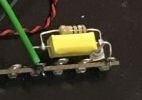1 last question if i may,a few years ago a valve went bang and took out a fuse and a resistor,the tech that fixed it when finished added a cap and resistor and a green wire to the circuit saying it was best practice/safer. ive always wondered what he meant or what they are doing?,can anyone tell me please?
you can see the added parts circled in red in the second photo.


you can see the added parts circled in red in the second photo.
Last edited:
Jamie123,
ask the tech that fixed it . At a minimum he should supply a schematics of the changes.
ask the tech that fixed it . At a minimum he should supply a schematics of the changes.
It's not visible clearly, that another wire (besides of the green one) is present.
Maybe it's simple hum cleaner:
parallel R//C (usually 10R//100nF) form device "ground" to safety earth of mains.
Maybe it's simple hum cleaner:
parallel R//C (usually 10R//100nF) form device "ground" to safety earth of mains.
the case...it's the last tag in the strip and if you look carefully you can make out the hardware.
I was afraid of that, so I also asked that is there another wire.
In my practice this method would be the last choice.
Any thin wire to safety earth connection on case (near to mains input, green wire from mains safety earth to case) would be better solution.
In my practice this method would be the last choice.
Any thin wire to safety earth connection on case (near to mains input, green wire from mains safety earth to case) would be better solution.
As we see in the left hand upper corner of the 1st pic, the chassis is safety grounded. We might discuss on the green wire's gauge, though. What has been added is, as yet said, a soft connection from signal to chassis ground. It might be safer, though, to replace it, or put in parallel with it, a pair of antiparallel rugged diodes.
Best regards!
Best regards!
There are really 2 questions here. First, yes it is absolutely mandatory that the mains inlet connector's earth pin is connected directly to the chassis close to the connector. Without this, any live or high voltage part that accidentally touched the chassis could kill you.thanks for the replies, so is it necessary?
The second is that it is usual to connect one point, and one point only, of the analog 0V to the chassis. In most well though out grounding schemes, this point is at the RCA input connector. Some people make the connection through a parallel resistor and capacitor combination. Spme people include a so called "ground lift" switch in series which can be helpful in some cases of ground loops.
Cheers
Ian
as Kay Pirinha pointed out the chassis is already earthed near the mains in at the back, as long as its not doing anything detrimental i will leave it in.
are you certain that, that ground is at the safety ground potential otherwise it means induced noise, according to the Dave Davenport article...
If the case is steel, the potentially induction between the safety earth point (near the mains inlet) and the screw (near the R//C) possibly generates hum.
Instead of it I would connect R//C "lower" leg with thin wire to safety earth point (not to case near the R//C).
Instead of it I would connect R//C "lower" leg with thin wire to safety earth point (not to case near the R//C).
thanks,whats the risk if i just remove it and the green wire all together?If the case is steel, the potentially induction between the safety earth point (near the mains inlet) and the screw (near the R//C) possibly generates hum.
Instead of it I would connect R//C "lower" leg with thin wire to safety earth point (not to case near the R//C).
Using device (which is not designed to "double insulation") without connecting case to safety earth, would be hazardous.thanks,whats the risk if i just remove it and the green wire all together?
Tubes itself has wide tolerances in its properties, so use high precision passive components is usually useless.thanks,yes leaving it alone is probably the best thing to do,i just wondered if by using better tolerance parts i'd gain a small improvment.
- Home
- Amplifiers
- Tubes / Valves
- a question for valve experts
